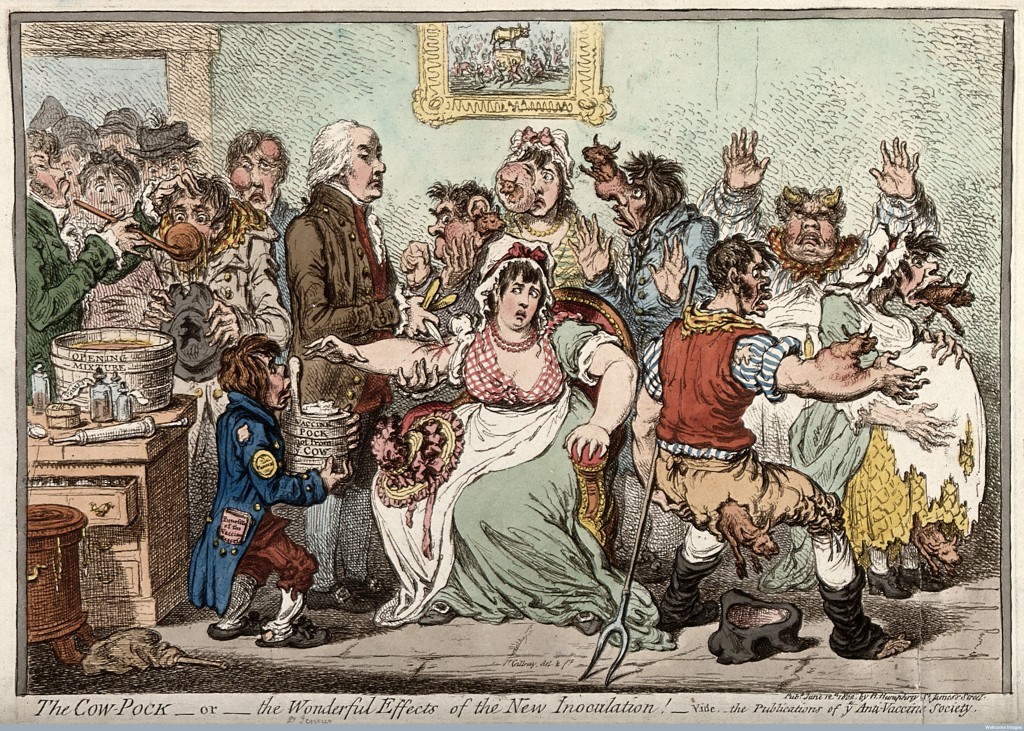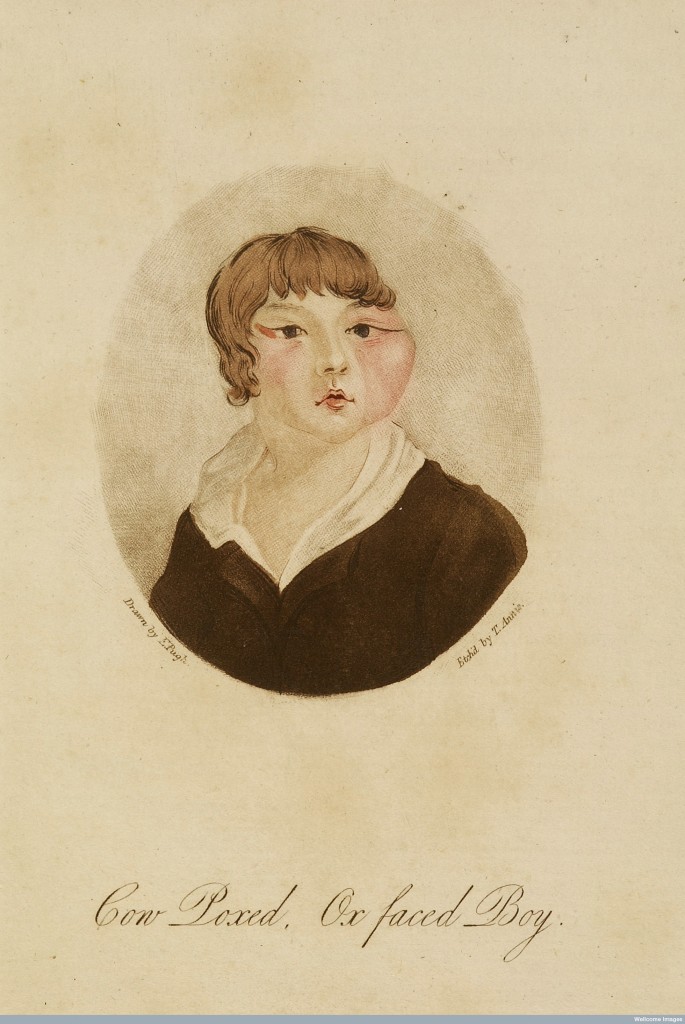The news is rife with fearful accounts of disease — influenza is epidemic and measles is re-emergent — and debates about how to inoculate against them. Opponents of vaccination, meanwhile, are fanning the flames of fear. Measles, for example, is entirely preventable, but remains among us because of concerns that the vaccine prophylactic is worse than the disease. The thoroughly debunked notion that the MMR vaccine causes autism is still at large, and with it a cluster of nebulous fears of Big Pharma conspiracies and the risks of contaminating children with manufactured diseases. Such fears are not new. Anxieties about vaccination are as old as vaccination itself.

At the turn of the 19th century, Edward Jenner’s method for preventing smallpox summoned the spectre of sinful flesh. Opponents likened vaccination to bestiality and compared the vaccine itself to a beastly sexual disease. The original ‘vaccine’, named after the cow from which it came, was a massive step forward in smallpox prevention. Until then, children were commonly inoculated with smallpox itself, which usually resulted in a light dose of the disease. Inoculation, however, killed many who underwent it, and left the rest fully contagious. Nevertheless, when Jenner’s Inquiry into the matter finally appeared in 1798, explaining how an animal disease would prevent a human one without resorting to dangerous inoculation, it attracted as much odium as it garnered support.
James Gillray’s popular 1802 print of the bestial effects of cowpox strikes the modern viewer as ridiculous: cows emerging from heads, trunks and limbs. Jenner stands centrally, penetrating the arm of a terrified patient with ‘vaccine pock, hot from ye cow’. The patient has previously been ‘opened’ by a special brew. To the right, those already vaccinated undergo a series of horrors caused by contamination with animal disease. The image is shot through with innuendo about sexual transgression (communing with the beast) and venereal disease (syphilis). The pregnant hag on the extreme right seems at once to vomit and give birth to bovine progeny, while behind her another matron sprouts the satyr-like horns of the beast. The breeches of a bumpkin are breached. The faces of others are marked by monstrous eruptions of ‘the pox’.
The image reflects the intensity of the debates and fears around vaccination. Gillray’s caption directs us to the publications of the ‘Anti-Vaccine Society’: not a formal body, but a reference to Jenner’s principal opponents. The prominent physician Benjamin Moseley was the culprit in chief, responding to the ‘Cowmania’ in 1800 with a series of concerns. While Jenner had styled cowpox Variolae Vaccinae, smallpox of the cow, Moseley called it Lues Bovilla, bovine syphilis, with all the long-term mental and nervous consequences of the human ‘pox’. He asked:
Can any person say what may be the consequence of introducing the Lues Bovilla, a bestial humour – into the human frame, after a long lapse of years? Who knows, besides, what ideas may rise in the course of time, from a brutal fever having excited its incongruous impressions on the brain? Who knows, also, but that the human character may undergo strange mutations from quadrupedan sympathy and that some modern Pasiphaë may rival the fables of old?
His classical reference might pass us by, but the invocation of bestiality would have been obvious to the educated in 1800. Pasiphaë, cursed by Poseidon, had copulated with a bull. Having built a wooden cow and covered it with cowhide, she had hidden inside it in order to receive her desired mate. She later gave birth to the Minotaur. Moseley played not only on the taint of venereal disease, but also on the fragility and sanctity of the human, warning of a hybrid and brutal progeny. Vaccination was not only dangerous, it was immoral.
The search was on for proof of the bestial consequences of being inseminated with animal disease. In 1805 Dr Rowley, who derived his living from the impugned technique of inoculating with smallpox, claimed to have found it and to have showed it to Moseley. Moseley marked the animalistic transformation and Rowley published exaggerated portraits of Gillray-esque figures, supposedly drawn from life. The ‘Ox-faced boy’ was presented as tangible proof of the brutal result of bestial infection. Beware the ‘modern chimera’, went the cry.

Vaccination did not properly shake the fear of bestial venereal disease until the end of the nineteenth century, with some still adamantly claiming an identity between cowpox and syphilis. From 1853, responsibility for administering the vaccine in England was put in the hands of the Poor Law Guardians. The association of vaccination with the workhouse caused a resurgence of the syphilitic fear among the well-to-do. Jenner’s innovation helped fuel concerns. After an initial vaccination from the cow, he realised that it could then be carried on from arm to arm. The matter from one vaccination pustule could be collected and inserted into the arm of the next child. What respectable mother would take her child to be contaminated with matter drawn from the arm of a ne’er-do-well? Cowpox was one thing, but what about all the other diseases that riddled the poor? The class system relied on bodies being kept apart. The State’s insistence on bringing them together seemed to risk the fabric of civilisation, even if the risk of disease was actually minute. While most doctors believed that cowpox was not related to syphilis, how could they be sure that the vaccine wasn’t tainted with the diseases of the immoral when incubated in the arms of the poor? Better to risk smallpox than to invite syphilis into one’s children.
The fearful kept their children away and a preventable disease continued to rage, often to epidemic proportions. The form taken by fear reflects the preoccupations of the society that produces it. In our times it is a fear of corporate Western medicine and its reckless advocates, forcing unknown risks upon our children. For early nineteenth-century anti-vaccinists, cowpox vaccination was a sordid and unholy communion, the embodiment of an immoral trinity: animality, bestiality and sexually transmitted disease.
 Rob Boddice is an historian of science, medicine and the emotions, based in Berlin. Educated in York, he has published books on the history of human-animal relations, anthropocentrism, and pain. His biography of Edward Jenner will be published this year, by the History Press. He is currently working on two books: The Science of Sympathy and Pain: A Very Short Introduction (Oxford University Press). Rob tweets from @virbeatum
Rob Boddice is an historian of science, medicine and the emotions, based in Berlin. Educated in York, he has published books on the history of human-animal relations, anthropocentrism, and pain. His biography of Edward Jenner will be published this year, by the History Press. He is currently working on two books: The Science of Sympathy and Pain: A Very Short Introduction (Oxford University Press). Rob tweets from @virbeatum

NOTCHES: (re)marks on the history of sexuality is licensed under a Creative Commons Attribution-NonCommercial-NoDerivatives 4.0 International License.
Based on a work at www.notchesblog.com.
For permission to publish any NOTCHES post in whole or in part please contact the editors at NotchesBlog@gmail.com




